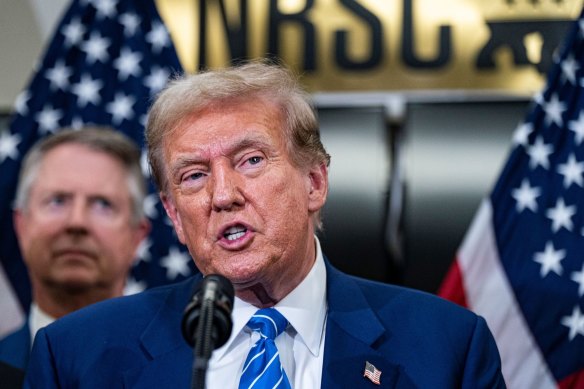
Inevitably, if the IEA were right, oil prices would be far lower than they are today (oil is trading around $US82 a barrel) and a lot of the increased oil company investment now being made would produce suboptimal returns.
Last year capital investment in oil and gas was almost $US540 billion, the most since 2019, and the oil majors, even those committed to meeting their net-zero commitments, have been scaling up their plans for future investment.

A Trump administration would radically affect the oil market.Credit: Bloomberg
While it foresees a big surplus of production over demand by the end of the decade, the IEA does see demand rising 3.2 million barrels a day from its current levels before it peaks. It thinks the market needs an extra 1.2 million barrels a day now to balance supply over the second half of this year.
OPEC+ has been in production-cutting mode over the past 18 months, taking nearly 6 million barrels a day out of the market.
Earlier this month, however, the cartel extended the cuts through to the end of next year while, at the same time, allowing some of its key members to unwind some of their “voluntary” cuts over the course of 2025.
OPEC has said it would need to boost supply by 2.7 million barrels a day to match supply with demand this year, although its plan to return some production has flexibility – it can pause or reverse the increase in production – which suggests a lack of confidence in its forecasts.
The collision of forecasts in the longer term is, however, more important than what might transpire over the next six to 18 months.
The two agencies’ mixed records on forecasting supply and demand are due to the unpredictability of the events that move a market extremely sensitive to external influences.
The pandemic, the war in Ukraine, the conflict in the Middle East, changes in the economic conditions or the administrations in advanced economies, are among the factors that can impact the market in the near term.
The slowdown in China’s growth rate, which looks to be a permanent shift in that economy’s trajectory, will be a particularly significant influence over demand for fossil fuels.
In the longer term, the pace at which the world, particularly the developed world and China, move towards net zero emissions will shape both sides of the supply and demand equation, and the take-up of EVs and investment in clean energy generation will play a major role.
There is some good news on that front.
The IEA (an ardent advocate for a response to climate change) says global investment in clean energy technologies and infrastructure will reach $US2 trillion this year, against “only” $US1 trillion invested in oil, gas and coal. China is the major player and investor in clean energy – it accounts for about a third of the total – followed by the EU and US.
There are also some less positive developments.
The two agencies’ mixed records on forecasting supply and demand are due to the unpredictability of the events that move a market extremely sensitive to external influences.
While global EV sales were about 35 per cent higher last year than in 2022 and production has ramped up significantly again this year, particularly from China, there is a glut of production and the unsold inventories of the major EV producers have been swelling. A similar situation is developing in solar panels.
Demand growth seems to have decelerated despite the overcapacity and a torrid price war that has reduced the cost of buying an EV in those economies without steep tariff barriers.
Demand for EVs and solar isn’t going to be helped by the new European Union tariffs on China-built EVs and a foreshadowed tariff response in the US and Europe to China’s solar panels. Nor will it be if Donald Trump, who sees EVs and the clean climate push as extreme outworkings of “wokeism”, regains the US presidency.
Loading
Trump plans a 60 per cent tariff on all Chinese manufactured products and would remove the Biden subsidies and incentives for green technologies.
Tariffs on China’s cheap EVs and solar technologies will push up their cost and slow their take-up in Europe and the US. The Biden administration has already imposed a 105 per cent tariff on China’s EVs and a 50 per cent duty on solar panels to encourage and protect domestic production.
Some of the world’s biggest car manufactures are also downgrading their efforts to roll out EVs, focusing more of their investment on internal combustion engines and hybrids as the growth in demand slows.
If aggressive targets for EVs and renewables aren’t met, the IEA’s forecast of a massive surplus of oil in 2030 would prove overly optimistic – or overly pessimistic, from an oil producers’ perspective.
Mind you, while a Trump administration would undo many of Joe Biden’s green energy policies, it would also encourage even more US oil and gas production, which is already at record levels.
“Drill, baby, drill” has become a Trump mantra. The IEA’s forecast surplus in the market for oil might still be achieved early next decade if Trump does return to the White House and US oil companies respond to his urgings with another big surge in output.
The Business Briefing newsletter delivers major stories, exclusive coverage and expert opinion. Sign up to get it every weekday morning.









 Add Category
Add Category